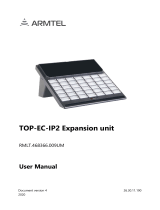
15
Description of new and updated functions
Gigaset DL500A / en / A31008-xxxx-xxxx-x-xxxx / Rel3_Saturn.fm / 12.01.2012
Version 4.1, 21.11.2007
Supplements and corrections to several functions
u Cancelling an incoming call:
To cancel an incoming call, replace the receiver. For VoIP and ISDN calls you have
additionally the possibility to press the red end key Tor the display key
§Reject§.
u Display during an incoming call with CNIP (country-specific):
If the number of the caller is stored in your directory, the caller’s number (not the
CNIP information) is replaced by the corresponding directory entry.
Both, CNIP and directory name replacement may be shown together.
u Making calls using network services (country-/provider-specific):
– For some functions, you must press the softkey
§Send§ instead of §OK§ or §Save§ to
submit changes.
– Cancelling ringback (ISDN):
To cancel ringback early select v
¢ ÇSelect Services ¢ Ringback Off
§OK§. Ringback is cancelled. You do not need to press any other key.
u Searching for subscribers in the Gigaset.net directory:
There is no display key
§Search§ available to start a search in the directory.
You can start a search as follows:
v
¢ Î Contacts ¢ Online Directories ¢ Gigaset.net
Gigaset.net name:
Enter the name or part of a name (max. 25 characters).
§Options§ ¢ Search
Select and press
§OK§, to start the search.
u Using Bluetooth devices:
Adding the data device/mobile phone to the known devices list:
If the new device fails to register, the list of known devices will only remain
unchanged if no device was selected to be replaced.
Connecting headsets:
You can connect a wire-bound headset and a Bluetooth headset to the base at
the same time. In this case you cannot use a function key with the wire-bound
headset.
u Changing the default connection:
When you switch the analogue fixed network over to ISDN or vice versa some
messages are displayed. The only available display key is
§OK§ and not any longer
§No§ and §Yes§. You can only agree to the system messages.
u Function/display key assignments:
Additionally to the listed functions in the user manual you can assign the SMS
menu to a function key for a quick access:
¤ Press and hold a function/display key.
¤ Select More Functions... and press §OK§.
¤ Select SMS and press §OK§.




















